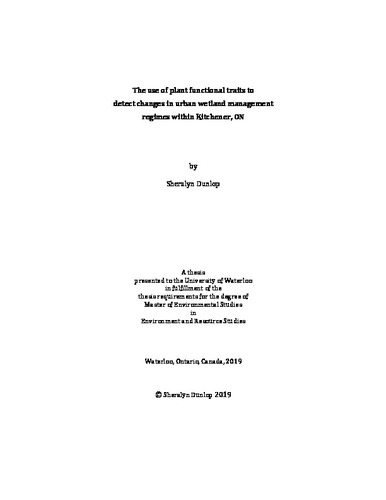| dc.description.abstract | Humans have modified their surrounding environment in ways that often lead to changes in ecosystem structure and function. Ecosystem management efforts are necessary to bring back functioning attributes of ecosystems for wildlife and human enjoyment. Ecosystem management provides a means of assessing ecosystem status, prioritizing, and outlining essential ecosystem goods and services. However, few projects are designed or funded to ensure that measures of success or failure are completed and reported so that lessons can be learned. Still, there are several conventional measures to assess success or site conditions that are used; many of these rely on assessment of taxonomic diversity. While useful as a fast, efficient and useful comparative indicator, diversity measures are usually an indirect measure of the need to conserve or restore ecosystem function. In contrast, plant functional traits potentially have a higher explanatory power in predicting ecosystem functionality, stability, invasibility, resource capture (i.e., allocation of nutrients to different plant structures), nutrient cycling, and the productivity of communities. A practical problem with functional traits may be that measuring them is more labour-intensive. This can be a problem for organisations with already limited funding. A more fundamental challenge is that functional trait measures were originally designed for use in phylogenetic studies, not as ecological indicators. Hence, this is the first research avenue to pursue.
My research focused on the comparison of above-ground and below-ground plant functional traits in Typha (cattail species) and Phalaris arundinacea (invasive reed canary grass) in different urban wetland management regimes within the City of Kitchener, Ontario, Canada. Passive management types included an on-line stormwater management facility (known as “no. 32”), a wetland created by agricultural activity (“Sunfish Pond, Huron Park Natural Area”), and a least disturbed natural wetland (“Borden Wetland”). Above-ground functional traits included maximum plant height, presence and absence of seedhead, and seedhead length in Typha. Below-ground plant functional traits were specific root length, root diameter, root length, root volume, root surface area, root tissue density, root density, and root ball volume. Typha measures included rhizome volume.
Comparing all urban wetland management regimes, there was a significant difference in maximum plant height of Typha. There was a significant difference in root volume measurements of Phalaris arundinacea between Borden Wetland and the on-line stormwater management facility. In Phalaris arundinacea, root length, root surface area, and root ball volume were significantly different between Sunfish Pond and Borden Wetland. Typha root diameter and root volume showed a statistically significant difference between Borden Wetland and the on-line stormwater management facility no. 32. Lastly, Typha showed a significant difference in specific root length and root density between Borden Wetland and Sunfish Pond versus the on-line stormwater management facility no. 32.
This study contributes to the state of knowledge regarding use of plant functional traits in measuring outcomes of choices (active or passive) of ecological management in these urban wetlands. Specifically, what this study showed is that root diameter, root volume, and maximum plant height in Typha species were the best traits to assess site conditions. These results suggest that there may be differences in the efficacy of different management regimes, or site characteristics, and that these are reflected by plant functional traits. The caveat is that the results were inconsistent between and within the species used; what should be tested by a follow up study is whether these results can be explained by the inherent variation in urban wetland ecosystem dynamics (e.g., sudden changes in water depth during precipitation events) facilitating more extreme plasticity in plant traits. | en |

